Descending a cliff used to be a straightforward affair: Climb down on your own two feet, base jump or zip on a squirrel suit and take a flying leap. Today, I’m going with option four.
I’m at 10,700 feet, atop Colorado’s Grand Mesa, the largest flat-top mountain in the world, poised to attempt the latest gauntlet in Western U.S. mountain biking: the Palisade Plunge, a 32-mile trail that ends 6,000 vertical feet below in the tiny town of Palisade. But contrary to its name, it is far more than a gravity-assisted plummet. The plunge also features 2,000 vertical feet of climbing, numerous highly technical sections and long stretches of white-knuckle exposure — all of which, according to the trail designers, make this an “epic point-to-point challenge” that “even intermediate riders will likely find . . . quite difficult.”
Two hours earlier on a crisp September morning, I piled into a shuttle van in Palisade with 11 other riders, including my friend Kurt Casey, 56, and his friend Yvonne Delahunty, 49, both from Steamboat Springs, Colo. Yvonne, a fiery, pigtailed New Zealander, used to race mountain bikes and remains as skilled and fearless as most riders half her age. Kurt, an athletic multisport adventurer, has more lives than a cat with a genie lamp.
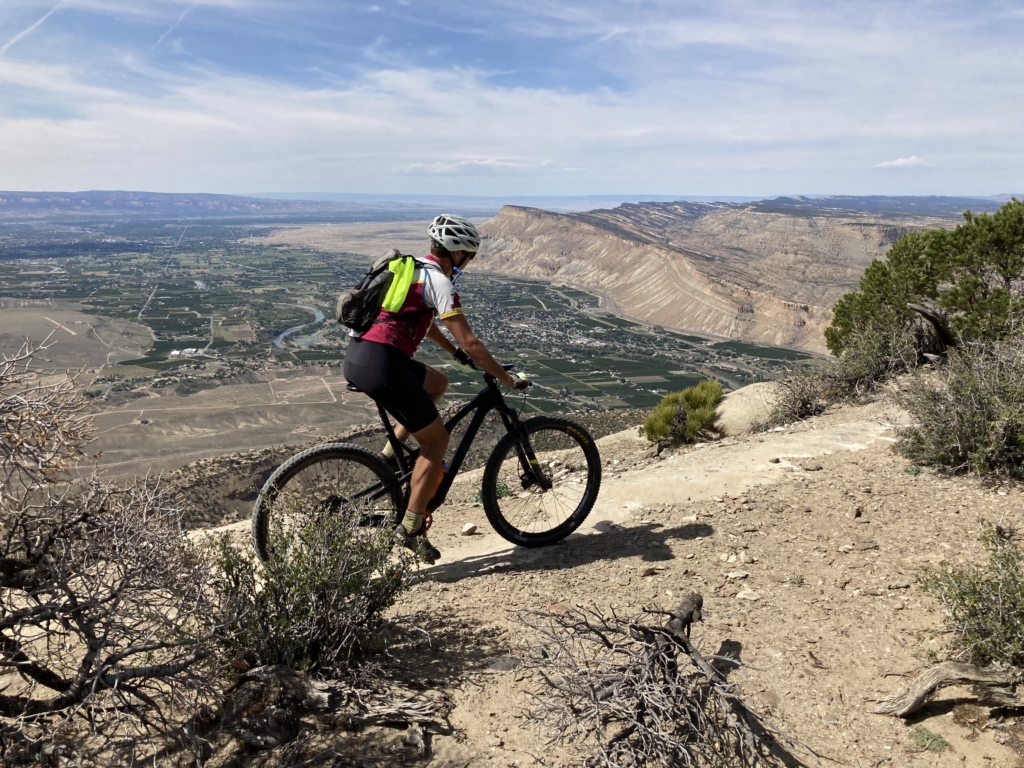
As the van labored up the Grand Mesa Scenic Byway, through mountains cloaked in autumn aspens and conifers, he recounted a story from a few weeks earlier that crescendoed with a bear chasing a bathrobed Kurt and his pet alpaca down a Steamboat road at dawn. This would have ended poorly — Kurt said he could feel the bear brush against him and smelled its breath — had his 12-year-old golden retriever not materialized at the last second and leaped on the ursa’s face.
If nothing else, the tale distracts me from my mounting anxiety about the Plunge. It wasn’t so much the warnings about the trail — “You might die” is standard fare on outdoor activity disclaimers — but whom they came from. During warm-up rides on dusty, chunky, challenging trails in nearby Fruita and Grand Junction, I met many hardcore local mountain bikers who tagged the Plunge as another level.
“You’re from D.C.? I hope you know what you’re getting into,” one said. “Wow, massive ride. Good luck!” offered another. “Rode it once and won’t ever do it again,” said Sienna Martin, a nurse from Grand Junction, when I met her on that city’s Lunch Loops trail system. “It’s hard, scary, long and not all that enjoyable.” Gulp.
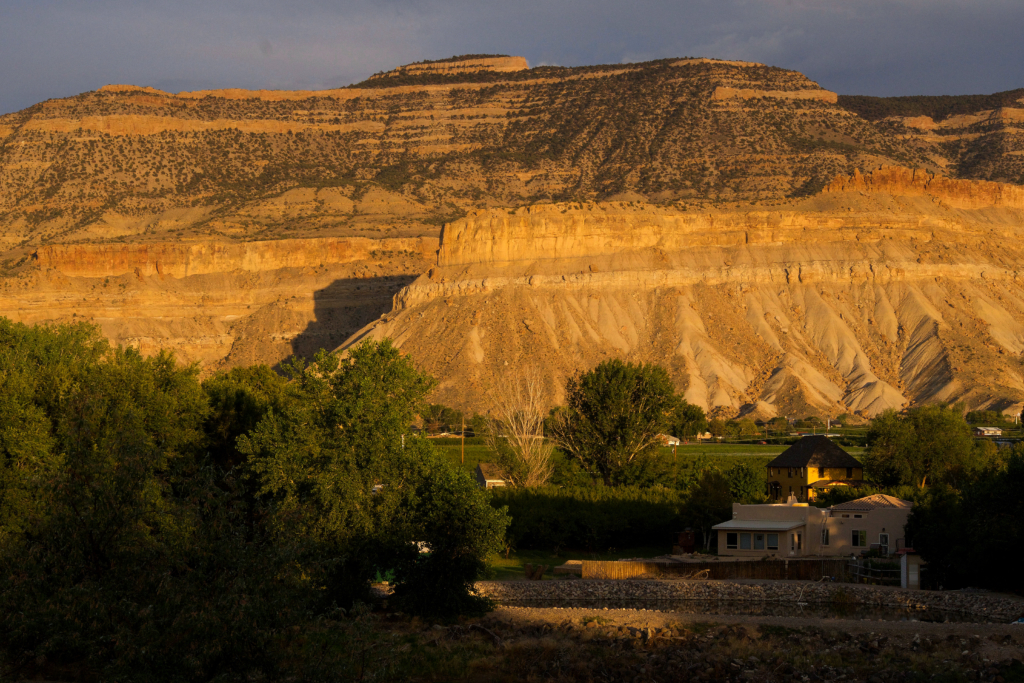
Even Rondo Buecheler, co-owner of Rapid Creek Cycles, which ran our shuttle and rented me a bike (a Kona Process 134 CR 29er, for you bike nerds), grilled me on my experience, fitness and tolerance for a grueling multi-hour ride. When he learned I had a pinched nerve that had limited my training, he essentially insisted I skip the first 11 miles of trail — a rumble across the top of the Grand Mesa that he and others described as flat, mundane and potholed by free-range cattle. “Even without that section, you’re still in for a long day,” Rondo said. “Trust me.”
After dropping Kurt, Yvonne and eight others at the Mesa Top trailhead, our van driver shuttles me and Geoff Roper, a mechanic at Rapid Creek, along a dirt road through clumpy meadows dotted with cows to a Forest Service parking area.
We saddle up and roll to a promontory that would give even some hikers pause: Otto’s Wall, built in the early 1900s for ranchers moving herds up and down the mesa. The 24-inch-wide trail clings to the basalt face like a lightning bolt, zigging down several hundred vertical feet in four tight switchbacks, one of which corners past a 100-foot sheer drop and two of which I unashamedly walk.
From there, the angle of the free fall lets up, but not the trajectory, and I shift my attention from the chunky loose rock on the trail to boulders jutting from the hillside to the immense sweep of spruce, fir and yellowing aspens that dissipates, miles below, into the gentle pastels of desert hills.
Tucked below them, running from Palisade to the Utah border, is the Grand Valley, a naturally chalk-dry landscape stamped with unnatural rectangles of vivid green — vineyards and fruit farms sustained by irrigation from the Colorado River as it cleaves west. This is the state’s fruit basket, celebrated with an autumnal bonanza of peaches, apples, pears, cherries and, in Palisade particularly, a robust year-round wine tourism industry.
In fact, when I ask 24-year-old native Liam Houston, whom I meet on the patio of the Palisade Brewing Company, about the essence of the town, he tells me: “We’re famous for peaches. Farmers markets and wine, too, but really the peaches. Had any?” I had (nearly perfect) but was more amused by the response from his friend Amadeus Wood, who chided him: “Dude, farmers markets and peaches? Seriously? I think he wants to talk about the Plunge.”
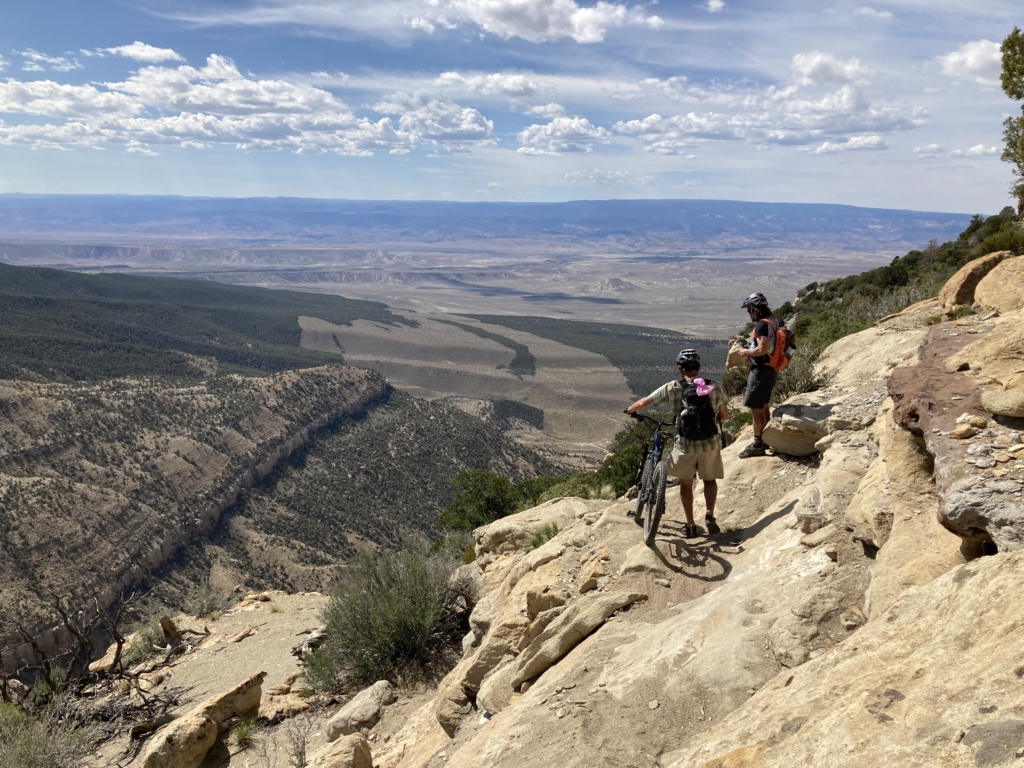
Truthfully, I welcomed the topic change, but this is an article on mountain biking, so: The Palisade Plunge joins a list of Western epics, including the 34-mile Whole Enchilada outside Moab, Utah; the 31-mile Monarch Crest near Salida, Colo.; and the 16-mile Downieville Downhill, which terminates in the eponymous Northern California town. I rode that last one in 2004, a rollicking descent from a rocky Sierra ridge through classic Cali forest, after which my hands hurt from braking and my face ached from smiling for three hours straight.
On mountain bikes in the Utah desert, a college reunion like no other
The Plunge has other plans. Crossing a rock pile below Otto’s Wall, I ram my knee into a handlebar and soon after twist an ankle while dismounting before a creek. But things improve when the trail dives into a grove of aspens, an intoxicating realm of filtered sunlight, loamy trail and the fragrant decay of autumn in the Rocky Mountains. The woods also deliver our first meaningful climbs, some laughably steep.
Yvonne is the first to catch us, careening through a corner with a lollipop in her mouth and both wheels off the ground as she is — what, singing? — to her turquoise Santa Cruz bike, which she calls Sweet Pea. “Yeah, I talk to her all the time,” Yvonne tells me later. “She’s gotten me down some crazy stuff, and sometimes I need to give her encouragement.”
Soon, a few others trundle by, then Kurt, who will hang with me for the duration.
The next 10 miles are the best of the day, with long stretches of soft, flowy dirt snaking through a mottled canvas of pinyon, juniper and oak brush beneath the sun-painted cliffs of the upper mesa. At one point, I climb a tree to get an angle for a photo and can see all too clearly the thousands of vertical feet and acres of sketchy terrain between us and Palisade.
But as long and tough as this trail is to ride, it took quite a bit more to plan and build it.
“This is 99 percent on public lands, so we had to do it in partnership — with Mesa County, Bureau of Land Management, the Forest Service and more,” says Scott Winans, who first conceived of the Plunge in 2010 and co-owns Rapid Creek Cycles with Rondo.
“We looked at how to leverage existing trailheads, make it easy to access and have it end right at the edge of Palisade. That took a lot of horse trading,” he said.
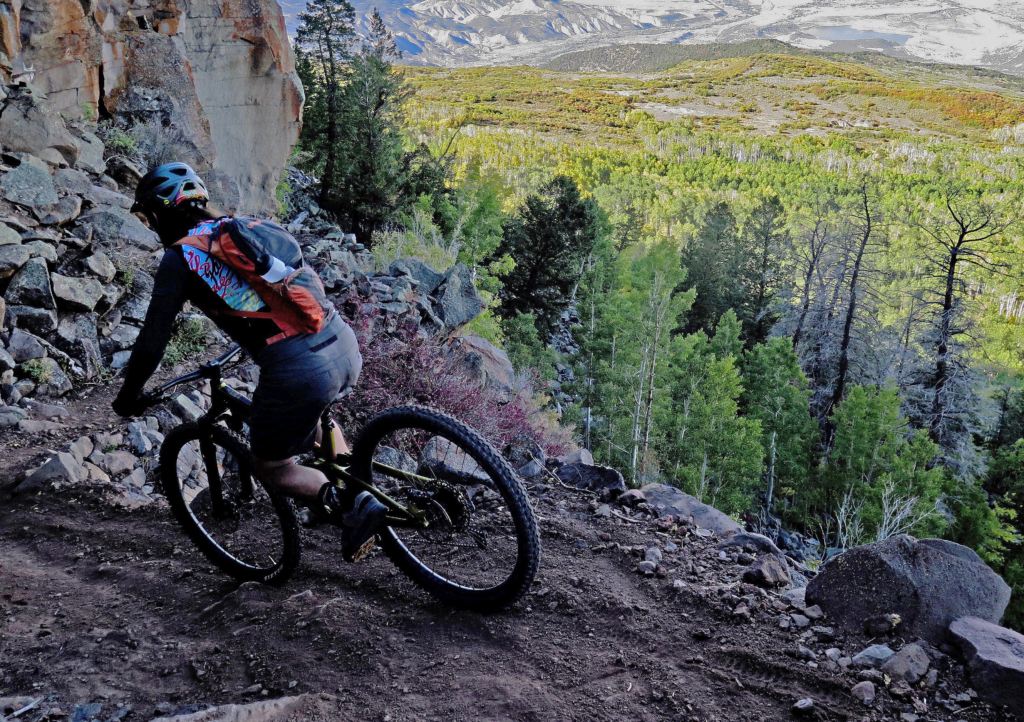
Scott, who’s also board president of the Colorado Plateau Mountain Bike Trail Association (COPMOBA), says the effort got a big boost from then-Gov. John Hickenlooper’s 2015 commitment to expand and build 16 trails across the state by 2016. “That pledge was a pipe dream, but the Palisade Plunge made it onto the list,” and COPMOBA secured grant funding, augmented by community donations, Scott says. As part of the deal, the association must raise $20,000 a year for trail maintenance. “We think this will really invigorate the community. People won’t come here just to ride the Plunge. They’ll spend days riding other trails in the area, but this is a marquee draw.”
At around 8,000 feet above sea level, we hit a sequence of sustained climbs and technical drops, including a couple of severe, awkwardly angled slabs more suited to mountaineering than cycling. This delivers us to an extended field of mogullike boulders, through which I repeatedly brace myself to somersault over the handlebars, only to watch as my 29-inch wheels surmount the next looming half-moon.
For the first time all day, I’m glad I skipped the top 11 miles. My right hand is cramping badly from terror braking, and I’m as mentally spent as if I had driven all night. The good news, I guess, is that we’ve descended enough to feel the baking heat of the desert, and from a broad plateau where we’ve paused, we can see the toylike houses and vineyards of Palisade below. Unfortunately, this is the start of what many consider the hardest part of the ride — five miles of ribbon-thin trail pasted onto the vast, cliffy, scree-littered slope of the mesa.
Fatigue makes it hard to steer. More than once, my front tire drifts into the talus, and I have to snap back to alertness to avoid catapulting down the scree. Halfway through this homestretch, Kurt runs out of water; I give him the extra half-liter I brought.
Finally, we weave into a slot canyon — our last mile. With the big-mountain exposure behind us, I feel as if the earth is hugging me, but the hard part isn’t over. As one commenter says in an online review: “The end of this trail is built like a haunted house. A flash flood zone with loose rock gardens and slippery jagged slabs around every corner. . . . I’m surprised the shuttle driver doesn’t sit with a chainsaw around the last turn just to ~spook~ you.”
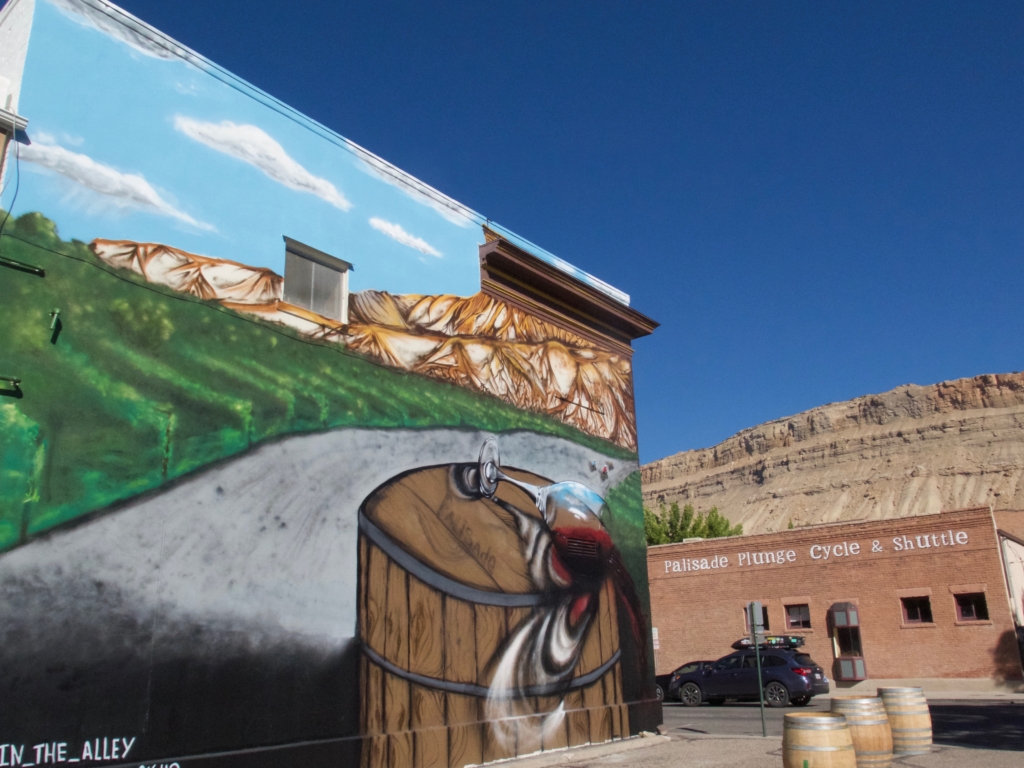
Inspired writing, but it wasn’t that bad. Overall, I found the Palisade Plunge far more manageable than I had feared — maybe a tepid endorsement, considering I had envisioned sidestepping along shoe-width cliffs while shouldering a bike. Besides, as Kurt says during our recovery beers at the brewery: “People need to read the trail description. It’s all there.”
The trail ends unceremoniously at an asphalt road, across which the Colorado River lazes by, along the path of least resistance, unbothered by whatever obstacles rise in its path.
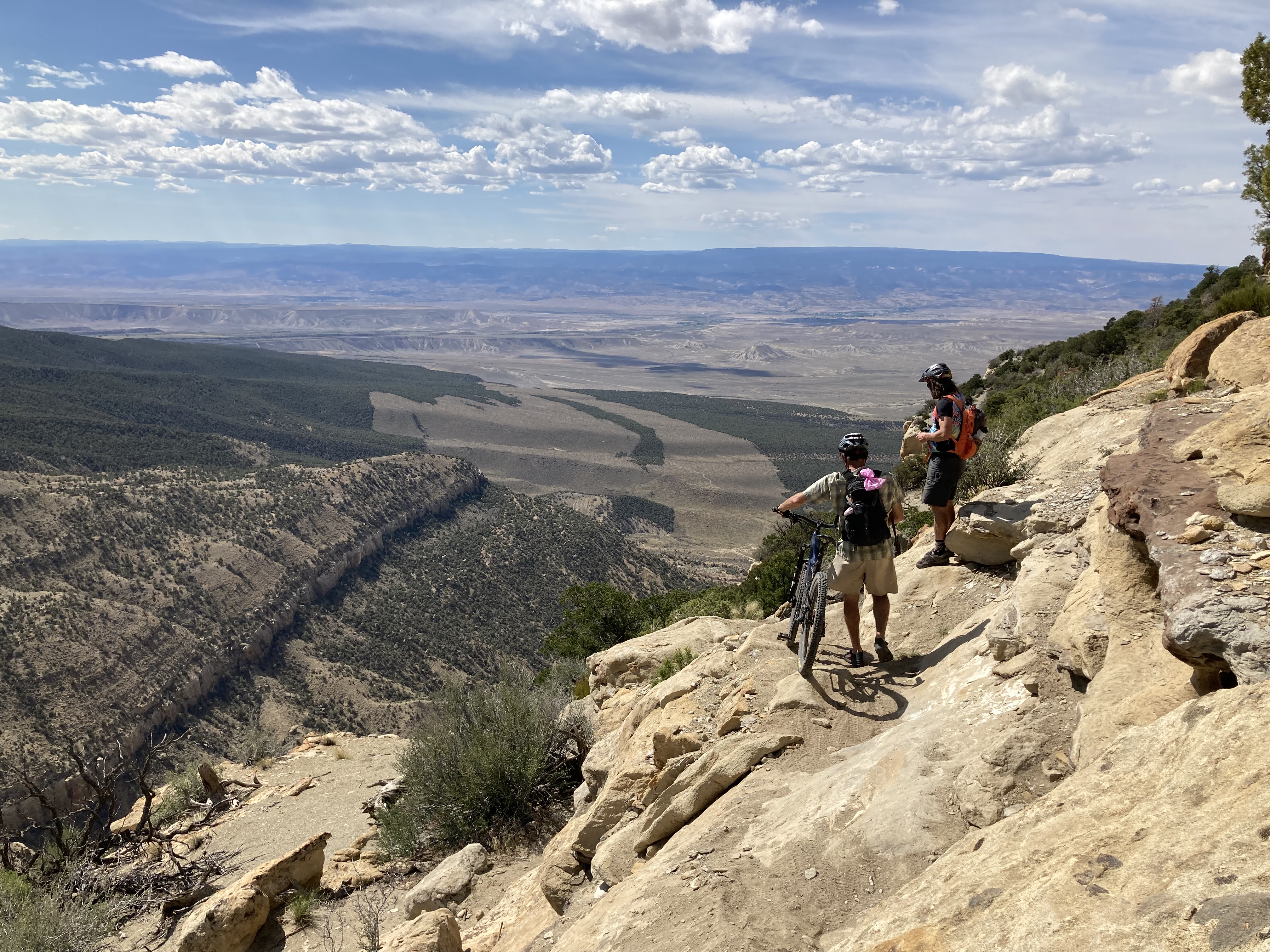
Comments